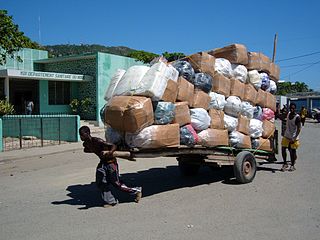
A cart or dray is a vehicle designed for transport, using two wheels and normally pulled by one or a pair of draught animals. A handcart is pulled or pushed by one or more people.

A carriage is a private four-wheeled vehicle for people and is most commonly horse-drawn. Second-hand private carriages were common public transport, the equivalent of modern cars used as taxis. Carriage suspensions are by leather strapping and, on those made in recent centuries, steel springs. Two-wheeled carriages are informal and usually owner-driven.

A wagon or waggon is a heavy four-wheeled vehicle pulled by draught animals or on occasion by humans, used for transporting goods, commodities, agricultural materials, supplies and sometimes people.

Milk delivery is a delivery service dedicated to supplying milk. This service typically delivers milk in bottles or cartons directly to customers' homes. This service is performed by a milkman, milkwoman, or milk deliverer.
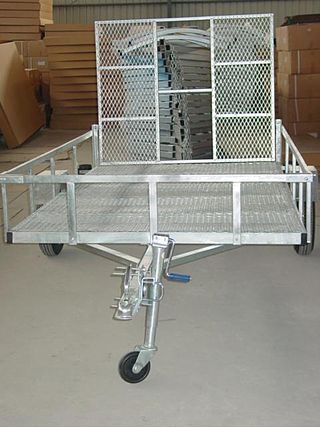
A trailer is an unpowered vehicle towed by a powered vehicle. It is commonly used for the transport of goods and materials.
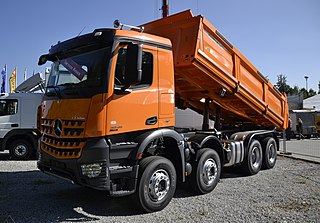
A dump truck, known also as a dumping truck, dump trailer, dumper trailer, dump lorry or dumper lorry or a dumper for short, is used for transporting materials for construction as well as coal. A typical dump truck is equipped with an open-box bed, which is hinged at the rear and equipped with hydraulic rams to lift the front, allowing the material in the bed to be deposited ("dumped") on the ground behind the truck at the site of delivery. In the UK, Australia, South Africa and India the term applies to off-road construction plants only and the road vehicle is known as a tip lorry, tipper lorry, tipper truck, tip truck, tip trailer or tipper trailer or simply a tipper.
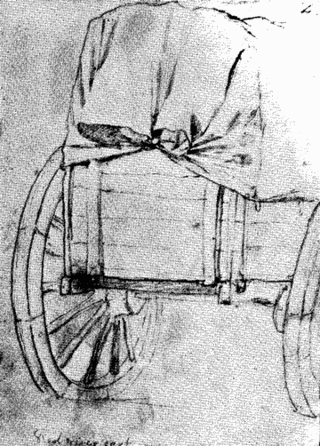
The Red River cart is a large two-wheeled cart made entirely of non-metallic materials. Often drawn by oxen, though also by horses or mules, these carts were used throughout most of the 19th century in the fur trade and in westward expansion in Canada and the United States, in the area of the Red River and on the plains west of the Red River Colony. The cart is a simple conveyance developed by Métis for use in their settlement on the Red River in what later became Manitoba. With carts, the Metis were not restricted to river travel to hunt bison. The Red River cart was largely responsible for commercializing the buffalo hunt.
A gun carriage is a frame and mount that supports the gun barrel of an artillery piece, allowing it to be maneuvered and fired. These platforms often had wheels so that the artillery pieces could be moved more easily. Gun carriages are also used on ships to facilitate the movement and aiming of large cannons.

A horse-drawn vehicle is a mechanized piece of equipment pulled by one horse or by a team of horses. These vehicles typically had two or four wheels and were used to carry passengers and/or a load. They were once common worldwide, but they have mostly been replaced by automobiles and other forms of self-propelled transport.

Among horse-drawn vehicles, a trolley was a goods vehicle with a platform body with four small wheels of equal size, mounted underneath it, the front two on a turntable undercarriage. The wheels were rather larger and the deck proportionately higher than those of a lorry. A large trolley is likely to have had a headboard with the driver's seat on it, as on a lorry but a smaller trolley may have had a box at the front of the deck or the driver seated on a corner of the deck and his feet on a shaft. With a very small trolley, the 'driver' may even have led the horse as a pedestrian. They were normally drawn by a single pony or horse but a large trolley would have a pair.
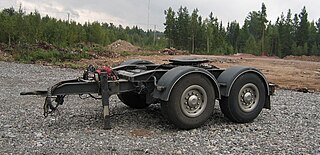
A dolly is an unpowered vehicle designed for connection to a tractor unit, truck or prime mover vehicle with strong traction power.

A semi-trailer is a trailer without a front axle. In the United States, the term is also used to refer to the combination of a truck and a semi-trailer; a tractor-trailer.

A flatbed truck is a type of truck which can be either articulated or rigid. As the name suggests, its bodywork is just an entirely flat, level 'bed' with no sides or roof. This allows for quick and easy loading of goods, and consequently they are used to transport heavy loads that are not delicate or vulnerable to rain, and also for abnormal loads that require more space than is available on a closed body.
Horse harness is a device that connects a horse to a vehicle or another type of load.

A coach is a large, closed, four-wheeled, passenger-carrying vehicle or carriage usually drawn by two or more horses controlled by a coachman, a postilion, or both. A coach has doors in its sides and a front and a back seat inside. The driver has a raised seat in front of the carriage to allow better vision. It is often called a box, box seat, or coach box. There are many of types of coaches depending on the vehicle's purpose.

A tank transporter is a combination of a heavy tractor unit and a mating full trailer or semi-trailer, used for transporting tanks and other armoured fighting vehicles. Some also function as tank recovery vehicles, the tractors of which may be armoured for protection in combat conditions.

A governess cart is a small two-wheeled horse-drawn cart. Their distinguishing feature is a small tub body, with two opposed inward-facing seats. They could seat four, although there was little room for four large adults. The driver sat sideways on one of these seats. The centre rear of the body was lowered, or else had a small hinged door, and there was a step beneath. The wheels were of moderate size, always fitted with mudguards, and usually carried on elliptical springs. The axle was either straight or dropped, giving a low, stable, centre of gravity.
Turning radius was a longstanding problem with wagons, dictated by the distance between the front wagon wheels and the bed of the wagon—namely, the point where the rotating wheels collide with the side of the wagon when turning. Many earlier designs required a very large turning radius; however, shrinking the width of the bed means decreasing the size of the load. As this is a problem that carts do not face, this factor, combined with their lighter weight, meant that carts were long preferred over wagons for many uses.
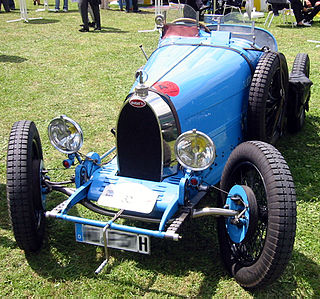
A dropped axle is the axle of a vehicle that is bent upwards towards the ends, i.e. the centre is 'dropped'. This gives two advantages: the centre of gravity of the bodywork is lowered relative to the wheels, which improves stability; secondly the wheels may be of larger diameter, giving a smoother ride over a rough surface.

Lewis Electruk was a British marque of milk floats, produced by T H Lewis Ltd, a company which had close ties with Express Dairies, the London-based retail milk company. They made pedestrian controlled vehicles (PCVs) and ride-on vehicles between 1934 and 1961. The manufacturing of battery electric road vehicles was then sold on to Morrison-Electricar who continued to build two Electruk models for the dairy industry. Major purchasers of their products included Express Dairies and the London Co-operative Society.

















